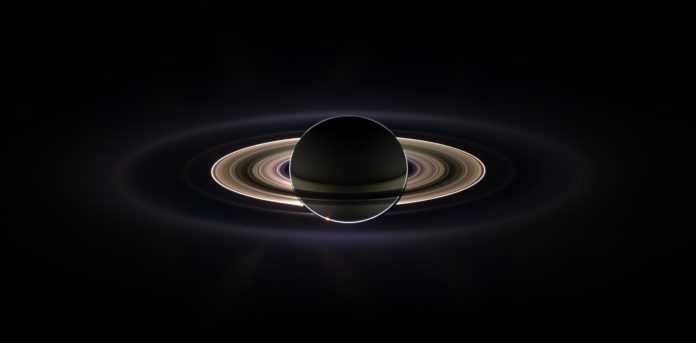Sixth from the Sun and second largest in the Solar System, the gas giant planet Saturn is best known for one thing: its rings.
While they may appear to be a solid structure surrounding the planet, they actually consist of countless pieces of ice and rock ranging in size from tiny pebbles to massive boulders. Astronomers still aren’t entirely sure when or how they formed.
Recent measurements from the Cassini orbiter have started to shed light on this gas giant’s past, however. And it turns out Saturn’s history may be written in its rings.
Seismology, or the study of waves through a body, has long been used to provide insight on the interior of the Earth. The speed of a wave or vibration varies depending on the type of material it’s travelling through, which means that studying these waves can tell us about the material deep within a planet’s interior.
Seismology can also help us learn about bodies that don’t have plate tectonics like the Earth — the Sun, for example, or a gas giant planet. In the Sun, the vibrations that are studied come from convection, which occurs when hot gas rises and cool gas sinks. This may occur in gas giant planets too, but astronomers still have a lot to learn about the interiors of these faraway worlds.
In the case of Saturn, seismology can tell us about impacts on the giant planet from long in the past, says University of Toronto astronomer Yanqin Wu. Her study was published in The Astrophysical Journal.
“Trembling from terrors of the deep past”
Saturn itself is ringing, like a bell, and the waves generated each time it’s struck propagate outwards to its ring system. This causes the rings themselves to oscillate, and these oscillations were visible to the Cassini orbiter as it watched Saturn in silhouette against the Sun.
By studying the amplitude and frequency of different oscillations, Wu was able to start piecing together the various events that could have led to each vibration in the first place. The main culprit seems to be large impacts from much earlier in Saturn’s history.
“Saturn [is] still […] trembling from terrors of the deep past,” she said.
The energies associated with giant impacts would be enough to excite most of the ringing that Wu observed. She also compared her results to impact rates inferred for Saturn by studying craters on its moons, and found them to be mostly consistent — with a few exceptions. Most of the oscillations can be explained by giant impacts, but some additional sources of ringing are needed to fully match the observations.
Wu hypothesizes that some of this may be due to exotic “rock storms” deep in Saturn’s interior. These would occur when iron-bearing species, for example, start to condense out of the atmosphere and rain down from the sky. While these could help explain some of the ringing, it’s still unclear if rock storms do actually occur on cool gas giant planets.
Another possibility is that Saturn experienced a giant impact much more recently in its history. While large impacts are relatively rare today, it’s not impossible that such an impact could have occurred within the past tens of thousands of years.
Wu’s study opens up the possibility of learning more about the impact history of gas giant planets, which lack visible impact craters like the Earth or the Moon. By studying these long-lived oscillations, astronomers may be able to shed further light on how and when Saturn’s extensive ring system first formed.









































